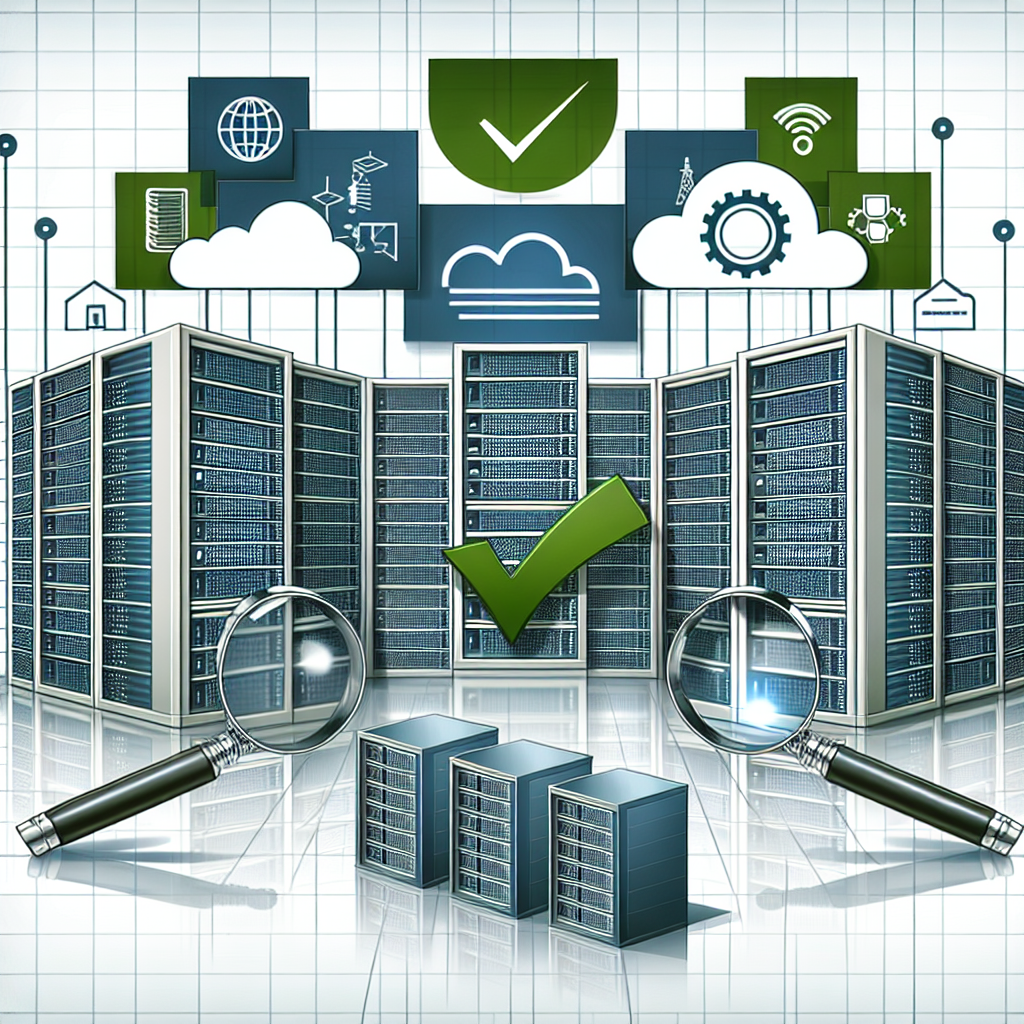Your cart is currently empty!
Tag: Data Center Service Level Agreements (SLAs)

Ensuring Compliance with Data Center SLAs: Best Practices for IT Managers
Data centers are the backbone of any organization’s IT infrastructure, providing the critical infrastructure needed to support business operations. As such, it is crucial for IT managers to ensure that data center service level agreements (SLAs) are being met to guarantee optimal performance and minimize downtime.SLAs are contractual agreements between a data center provider and its customers, outlining the level of service that will be provided. These agreements typically include metrics such as uptime, response times, and maintenance schedules. By adhering to SLAs, organizations can ensure that their data center operations run smoothly and efficiently.
To ensure compliance with data center SLAs, IT managers should follow these best practices:
1. Regular Monitoring and Reporting: IT managers should regularly monitor key performance indicators (KPIs) outlined in the SLAs, such as uptime, response times, and bandwidth usage. By tracking these metrics, IT managers can quickly identify any deviations from the agreed-upon service levels and take corrective action.
2. Establish Clear Communication Channels: Effective communication between the data center provider and the organization is essential for ensuring compliance with SLAs. IT managers should establish clear lines of communication with the data center provider to address any issues or concerns promptly.
3. Conduct Regular Audits: Regular audits of the data center infrastructure can help IT managers identify potential vulnerabilities and ensure that all systems are functioning optimally. Audits should include checks of hardware, software, security protocols, and disaster recovery plans.
4. Implement Redundancy and Disaster Recovery Plans: Data center downtime can have significant financial and reputational implications for an organization. To minimize the risk of downtime, IT managers should implement redundancy measures and disaster recovery plans to ensure that data can be quickly restored in the event of a failure.
5. Partner with Reliable Data Center Providers: Choosing a reputable data center provider is essential for ensuring compliance with SLAs. IT managers should thoroughly vet potential providers, ensuring that they have a track record of reliable service and can meet the organization’s specific needs.
In conclusion, ensuring compliance with data center SLAs is critical for maintaining optimal performance and minimizing downtime. By following these best practices, IT managers can effectively monitor performance, communicate effectively with data center providers, conduct regular audits, implement redundancy measures, and partner with reliable providers to ensure that SLAs are met. By prioritizing SLA compliance, organizations can ensure that their data center operations run smoothly and efficiently, supporting their overall business goals.

The Role of Data Center SLAs in Ensuring Uptime and Performance
In the rapidly evolving world of technology, data centers play a crucial role in ensuring the smooth operation of businesses and organizations. These facilities house and manage large amounts of data, applications, and services that are essential for the day-to-day operations of companies. With the increasing reliance on data centers for critical operations, ensuring uptime and performance has become a top priority for data center operators.One of the key tools that data center operators use to guarantee uptime and performance is the Service Level Agreement (SLA). An SLA is a contract between the data center operator and the client that outlines the level of service that will be provided, including uptime guarantees, performance metrics, and response times. By clearly defining the expectations and responsibilities of both parties, SLAs help to ensure that the data center meets the needs of the client and maintains a high level of service.
Uptime is a critical metric for data centers, as any downtime can result in significant financial losses and damage to the reputation of the facility. SLAs typically include uptime guarantees, such as 99.9% uptime, which means that the data center will be operational 99.9% of the time. To achieve this level of uptime, data center operators implement redundant systems, backup power supplies, and disaster recovery plans to minimize the risk of downtime.
Performance is another important aspect of data center operations, as clients rely on the facility to deliver fast and reliable access to their data and applications. SLAs often include performance metrics, such as response times for requests and data transfer speeds, to ensure that the data center meets the performance requirements of the client. By monitoring and measuring these metrics, data center operators can identify and address any performance issues before they impact the client.
In addition to uptime and performance guarantees, SLAs also outline the responsibilities of both parties in the event of a service outage or performance degradation. For example, the SLA may specify the steps that the data center operator will take to restore service and compensate the client for any losses incurred during the downtime. By clearly defining these responsibilities in advance, SLAs help to minimize confusion and disputes between the data center operator and the client.
Overall, the role of data center SLAs in ensuring uptime and performance cannot be overstated. By establishing clear expectations, responsibilities, and guarantees, SLAs help to create a framework for effective communication and collaboration between data center operators and their clients. With the increasing importance of data centers in today’s digital economy, SLAs are essential tools for ensuring that data centers deliver the high level of service that clients expect.

How to Negotiate a Data Center SLA that Works for Your Business
In today’s digital age, data centers have become a crucial component of any business operation. These facilities house and manage the vast amounts of data that companies rely on to run their day-to-day operations. With so much at stake, it’s essential for businesses to negotiate a Service Level Agreement (SLA) that works for their specific needs.An SLA is a contract between a data center provider and a business that outlines the terms and conditions of the services being provided. It typically includes details such as uptime guarantees, response times for support requests, and security measures. Negotiating a strong SLA is essential for ensuring that your data center provider meets your business needs and provides the level of service required to keep your operations running smoothly.
Here are some tips for negotiating a data center SLA that works for your business:
1. Define your requirements: Before entering into negotiations with a data center provider, it’s important to clearly define your business requirements. This includes determining the level of uptime you need, the security measures that are important to you, and the level of support you expect. Having a clear understanding of your needs will help you negotiate an SLA that meets your specific requirements.
2. Understand the provider’s capabilities: It’s essential to have a good understanding of the capabilities of the data center provider you are negotiating with. This includes knowing their track record of uptime, their security measures, and their customer support processes. By understanding their capabilities, you can negotiate an SLA that aligns with what they can realistically deliver.
3. Negotiate uptime guarantees: Uptime is a critical factor when it comes to data center services. Negotiate with your provider to ensure that they can meet the uptime requirements of your business. This may include penalties for downtime that exceeds the agreed-upon threshold, to ensure that the provider takes uptime seriously.
4. Include security measures: Data security is paramount in today’s digital landscape. Make sure that your SLA includes specific security measures that are important to your business, such as regular security audits, encryption protocols, and access controls. Negotiate with your provider to ensure that they can meet your security requirements.
5. Define support levels: It’s important to have a clear understanding of the level of support that will be provided by your data center provider. This includes response times for support requests, escalation procedures, and the availability of technical support staff. Make sure that your SLA includes specific support levels that meet the needs of your business.
Negotiating a data center SLA that works for your business is essential for ensuring that your data center provider meets your specific requirements. By defining your needs, understanding the provider’s capabilities, and negotiating key terms such as uptime guarantees, security measures, and support levels, you can create an SLA that aligns with your business needs and helps to keep your operations running smoothly.

The Future of Data Center SLAs: Trends and Innovations to Watch
In the rapidly evolving world of technology, data centers play a crucial role in ensuring the smooth functioning of businesses and organizations. As the demand for data storage and processing continues to grow, data center service level agreements (SLAs) are becoming increasingly important in guaranteeing the reliability and performance of these facilities. With advancements in technology and changing customer expectations, the future of data center SLAs is set to undergo significant transformations. Let’s take a look at some of the key trends and innovations to watch in the coming years.One of the major trends shaping the future of data center SLAs is the shift towards more personalized and flexible agreements. Traditionally, SLAs have been rigid documents that outline specific metrics and performance targets. However, as businesses seek to tailor their IT infrastructure to meet their unique needs, there is a growing demand for SLAs that are more customizable and adaptable. This includes the ability to easily scale resources up or down, as well as the option to add or remove services as required.
Another important trend in data center SLAs is the focus on sustainability and environmental responsibility. With increasing concerns about climate change and the environmental impact of data centers, customers are looking for providers that prioritize energy efficiency and green practices. This includes commitments to using renewable energy sources, reducing carbon emissions, and implementing environmentally friendly cooling systems. In the future, we can expect to see more stringent requirements for sustainability in data center SLAs, as well as greater transparency and reporting on environmental performance.
Innovation in technology is also driving changes in data center SLAs. With the rise of artificial intelligence, machine learning, and automation, data centers are becoming more efficient and reliable than ever before. This means that SLAs can now include guarantees for predictive maintenance, proactive monitoring, and real-time performance optimization. Providers are also exploring the use of blockchain technology to enhance security and transparency in data center operations, which could lead to new types of SLAs focused on data integrity and privacy.
As data centers become increasingly interconnected and distributed, another key trend to watch is the emergence of hybrid and multi-cloud SLAs. With many organizations now using a combination of on-premises, cloud, and edge computing resources, there is a growing need for SLAs that cover multiple environments and providers. This includes ensuring seamless connectivity, data portability, and consistent performance across different platforms. In the future, we can expect to see more comprehensive and integrated SLAs that span the entire IT infrastructure, regardless of where resources are located.
Overall, the future of data center SLAs is set to be dynamic and innovative, with a focus on personalization, sustainability, technology, and hybrid environments. As businesses continue to rely on data centers for their critical operations, providers will need to adapt and evolve their SLAs to meet the changing needs of customers. By staying ahead of these trends and embracing new technologies, data center providers can ensure that their SLAs remain relevant and valuable in the digital age.

Choosing the Right Data Center Provider: Evaluating SLAs
In today’s digital age, data centers play a crucial role in ensuring the smooth operation of businesses. With the increasing reliance on digital data and applications, it is essential for companies to choose the right data center provider to meet their specific needs. One of the key factors to consider when evaluating data center providers is their Service Level Agreements (SLAs).SLAs are contractual agreements that outline the level of service that a data center provider will deliver to their customers. These agreements typically cover aspects such as uptime, security, and support services. When evaluating SLAs, it is important to consider the following factors:
1. Uptime: One of the most critical aspects of a data center SLA is the uptime guarantee. This refers to the percentage of time that the data center’s services will be available to customers. A high uptime guarantee is essential for businesses that rely on their data center for critical operations. Look for data center providers that offer a minimum of 99.99% uptime guarantee.
2. Security: Data security is another important consideration when evaluating SLAs. A reputable data center provider should have robust security measures in place to protect against cyber threats and unauthorized access. Ensure that the SLA includes details on the security protocols and compliance certifications that the data center adheres to.
3. Support services: In the event of a technical issue or downtime, it is crucial to have access to reliable support services. Evaluate the SLA to understand the level of support that the data center provider offers, including response times, escalation procedures, and communication channels. Look for providers that offer 24/7 support and have a dedicated team of experts available to assist with any issues.
4. Scalability: As your business grows, your data center requirements may change. It is essential to choose a data center provider that can scale their services to accommodate your evolving needs. Evaluate the SLA to ensure that the provider can quickly and efficiently adjust their services to meet your changing requirements.
5. Compliance: Depending on the industry that your business operates in, you may be subject to specific regulatory requirements and data protection laws. Ensure that the data center provider’s SLA includes details on compliance with relevant regulations, such as GDPR, HIPAA, or PCI DSS.
In conclusion, choosing the right data center provider is a critical decision for businesses looking to ensure the security, reliability, and scalability of their digital infrastructure. When evaluating SLAs, consider factors such as uptime guarantees, security measures, support services, scalability, and compliance. By carefully reviewing and comparing SLAs from different providers, businesses can make an informed decision and select a data center provider that meets their specific needs and requirements.

The Role of Data Center SLAs in Disaster Recovery Planning
In today’s digital age, data centers play a critical role in ensuring the smooth operation of businesses and organizations. These facilities house and manage the vast amount of data that is generated and processed on a daily basis. However, with the increasing reliance on data centers, the need for disaster recovery planning has become more important than ever.Disasters can strike at any time, whether it be a natural disaster like a hurricane or earthquake, or a man-made event such as a cyber-attack or power outage. In the event of a disaster, the ability to recover data and resume operations quickly is crucial for businesses to minimize downtime and prevent significant financial losses.
This is where Service Level Agreements (SLAs) come into play. SLAs are formal agreements between a data center provider and their clients that outline the level of service that will be provided, including disaster recovery measures. These agreements set out specific expectations and responsibilities for both parties, ensuring that the data center is held accountable for maintaining a certain level of service.
When it comes to disaster recovery planning, data center SLAs play a crucial role in ensuring that businesses are adequately prepared for any potential disruptions. These agreements typically include provisions outlining the data center’s response time in the event of a disaster, as well as the procedures for data backup and recovery.
By establishing clear SLAs with their data center provider, businesses can ensure that they have a solid disaster recovery plan in place. This can help to minimize the impact of a disaster on their operations and prevent any long-term damage to their reputation.
In addition to setting out expectations for disaster recovery, data center SLAs also help to establish a level of trust between the data center provider and their clients. By formalizing the terms of the agreement, both parties can have confidence that the data center will uphold their end of the bargain and provide the necessary support in the event of a disaster.
Overall, the role of data center SLAs in disaster recovery planning cannot be understated. These agreements help to ensure that businesses are adequately prepared for any potential disruptions and have a clear roadmap for recovering their data and resuming operations. By establishing strong SLAs with their data center provider, businesses can rest assured that their critical data is in safe hands and that they have the necessary support to weather any storm.

Ensuring Compliance and Security in Data Center SLAs
In today’s digital age, data centers play a crucial role in storing, processing, and managing vast amounts of information for organizations of all sizes. With the increasing reliance on data centers, it is essential for businesses to ensure compliance and security in their Service Level Agreements (SLAs) to protect their sensitive data and maintain the integrity of their operations.Compliance and security are two key components of any data center SLA. Compliance refers to adhering to industry regulations and standards, such as the General Data Protection Regulation (GDPR) or the Health Insurance Portability and Accountability Act (HIPAA). Failure to comply with these regulations can result in hefty fines and damage to a company’s reputation. Security, on the other hand, involves protecting data from unauthorized access, breaches, and cyber threats.
To ensure compliance and security in data center SLAs, organizations should consider the following best practices:
1. Clearly define compliance requirements: When drafting a data center SLA, it is important to clearly outline the compliance requirements that must be met by the service provider. This includes specifying which regulations and standards apply to the organization’s data and the measures that will be taken to ensure compliance.
2. Implement security controls: Data centers should have robust security controls in place to protect sensitive information from unauthorized access and cyber threats. This may include firewalls, encryption, access controls, and monitoring systems to detect and respond to security incidents.
3. Conduct regular audits and assessments: Regular audits and assessments of data center operations can help identify any compliance or security gaps and ensure that the service provider is meeting the requirements outlined in the SLA. These audits should be conducted by independent third parties to provide an objective evaluation of the data center’s security posture.
4. Include breach notification procedures: In the event of a security breach or data loss, it is important to have clear procedures in place for notifying the organization and any affected parties. This includes detailing the steps that will be taken to investigate the breach, mitigate the impact, and prevent future incidents.
5. Monitor performance and compliance: Monitoring the performance and compliance of the data center service provider is essential to ensure that they are meeting the terms of the SLA. This includes tracking key performance indicators, conducting regular reviews, and addressing any issues or concerns in a timely manner.
By following these best practices, organizations can ensure compliance and security in their data center SLAs, safeguarding their sensitive data and maintaining the trust of their customers. In today’s increasingly digital world, protecting data has never been more important, and a strong SLA is essential for ensuring that data centers meet the highest standards of compliance and security.

Measuring the Success of Data Center SLAs: KPIs and Metrics to Monitor
In today’s digital age, data centers play a critical role in the success of businesses around the world. These facilities house and manage vast amounts of data that are essential for everyday operations. To ensure that data centers are operating at peak performance, Service Level Agreements (SLAs) are put in place to establish clear expectations between the data center provider and the client.Measuring the success of data center SLAs is crucial for both parties involved. Key Performance Indicators (KPIs) and metrics are used to monitor the performance of the data center and ensure that it is meeting the agreed-upon standards. By tracking these KPIs and metrics, businesses can identify any potential issues and make necessary improvements to ensure the smooth operation of their data center.
One of the most important KPIs to monitor is uptime. Uptime refers to the amount of time that a data center is operational and available to clients. Downtime can have a significant impact on a business, leading to lost revenue, decreased productivity, and damaged reputation. By monitoring uptime, businesses can ensure that their data center is consistently available and performing at an optimal level.
Another important metric to monitor is response time. Response time measures how quickly the data center is able to respond to client requests and resolve any issues that may arise. A fast response time is essential for maintaining customer satisfaction and minimizing downtime. By tracking response time, businesses can identify any bottlenecks or inefficiencies in their data center operations and make necessary improvements.
In addition to uptime and response time, other KPIs and metrics that businesses should monitor include data transfer speeds, security measures, and compliance with regulatory requirements. By tracking these metrics, businesses can ensure that their data center is operating at peak performance and meeting the expectations outlined in the SLA.
Overall, measuring the success of data center SLAs is essential for ensuring the smooth operation of a business. By monitoring key performance indicators and metrics, businesses can identify any potential issues and make necessary improvements to ensure that their data center is meeting the agreed-upon standards. By taking a proactive approach to monitoring SLAs, businesses can minimize downtime, maximize productivity, and maintain customer satisfaction.

Maximizing Performance and Reliability with Data Center SLAs
In today’s digital age, data centers play a crucial role in ensuring the smooth operation of businesses and organizations. These facilities house the servers, storage, and networking equipment that store and process vast amounts of data, enabling businesses to deliver services and applications to their customers.However, with the increasing reliance on data centers, it has become essential for organizations to maximize performance and reliability to ensure seamless operations. This is where Service Level Agreements (SLAs) come into play.
SLAs are contractual agreements between a service provider (in this case, the data center) and the customer that outline the level of service that will be provided. These agreements typically include metrics such as uptime guarantees, response times, and resolution times for issues.
By implementing SLAs with data centers, organizations can ensure that their critical data and applications are always available and performing at optimal levels. Here are some ways in which organizations can maximize performance and reliability with data center SLAs:
1. Define clear performance metrics: When negotiating an SLA with a data center provider, it is essential to clearly define the performance metrics that are important to your organization. This could include uptime guarantees, response times for support requests, and performance benchmarks for applications.
2. Set realistic expectations: It is important to set realistic expectations in the SLA to ensure that the data center provider can meet the agreed-upon performance levels. This includes understanding the capabilities of the data center infrastructure and the potential limitations that may impact performance.
3. Monitor and track performance: Once the SLA is in place, organizations should regularly monitor and track performance metrics to ensure that the data center provider is meeting the agreed-upon service levels. This can help identify any potential issues early on and allow for corrective action to be taken.
4. Implement redundancy and failover mechanisms: To maximize reliability, organizations should work with their data center provider to implement redundancy and failover mechanisms. This can help ensure that critical systems remain operational in the event of hardware failures or other issues.
5. Regularly review and update the SLA: As business needs and technology evolve, it is important to regularly review and update the SLA to ensure that it remains relevant and meets the organization’s requirements. This can help ensure that the data center provider continues to deliver high-performance and reliable services.
In conclusion, maximizing performance and reliability with data center SLAs is essential for ensuring the smooth operation of businesses and organizations. By defining clear performance metrics, setting realistic expectations, monitoring performance, implementing redundancy and failover mechanisms, and regularly reviewing and updating the SLA, organizations can ensure that their critical data and applications are always available and performing at optimal levels.

Key Components of Data Center SLAs: What You Need to Know
Data centers play a crucial role in keeping businesses running smoothly by storing and managing vast amounts of data. To ensure that data centers are performing at their best, Service Level Agreements (SLAs) are put in place to outline the expectations and standards for service delivery. Understanding the key components of data center SLAs is essential for both data center providers and their clients.One of the most important components of a data center SLA is uptime. Uptime refers to the amount of time that a data center is operational and available for use. Most data center SLAs guarantee a certain level of uptime, typically measured as a percentage. For example, a data center SLA might guarantee 99.9% uptime, meaning that the data center will be operational and available for 99.9% of the time.
Another key component of data center SLAs is performance. Performance metrics can include factors such as network latency, data transfer speeds, and response times. Data center SLAs often outline specific performance benchmarks that must be met in order to ensure that the data center is operating efficiently.
Security is also a critical component of data center SLAs. Data centers store sensitive and valuable information, so it is essential that they have robust security measures in place to protect this data. Data center SLAs should outline the security protocols and procedures that are in place to safeguard data from unauthorized access or breaches.
Scalability is another important component of data center SLAs. As businesses grow and their data storage needs increase, data centers must be able to scale their services accordingly. Data center SLAs should outline the process for scaling up or down, as well as any associated costs or limitations.
Lastly, data center SLAs should include provisions for disaster recovery and business continuity. In the event of a natural disaster, cyber attack, or other unforeseen event, data centers must have plans in place to quickly recover data and resume operations. Data center SLAs should outline the disaster recovery protocols and procedures that are in place to minimize downtime and data loss.
In conclusion, understanding the key components of data center SLAs is essential for both data center providers and their clients. By ensuring that data center SLAs cover uptime, performance, security, scalability, and disaster recovery, businesses can be confident that their data is being stored and managed effectively. By setting clear expectations and standards for service delivery, data center SLAs help to ensure that businesses can rely on their data centers to keep their operations running smoothly.
